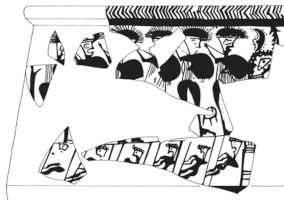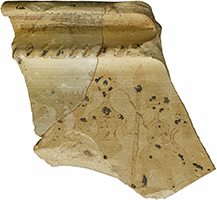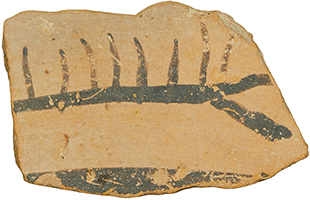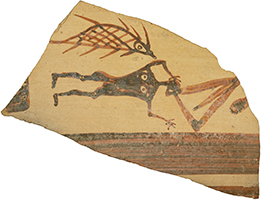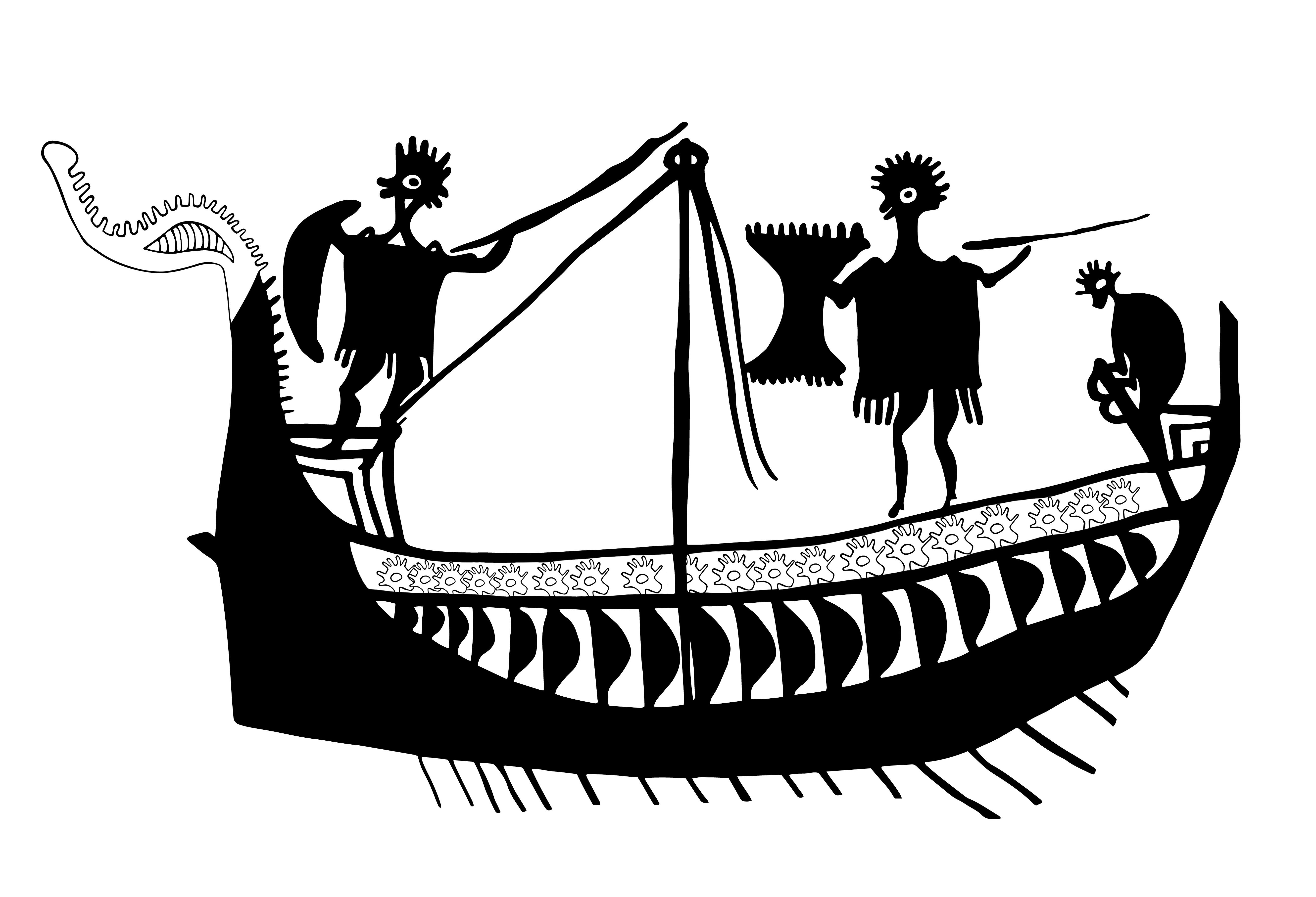The two vessels are nearly identical, with differences in only two secondary details: the absence of semicircles on the bulwark of the left ship, and the thin vertical lines filling two of the open spaces of its platform. The right galley facing left in nearly complete state and depicted in great detail. Parts missing include the bird-headed device topping the stem, the lower part of the stem, the end of the sternpost together with the blades of the single quarter rudder, and the two sternmost oars.
Low flat hull with a vertical, semi-integrated stempost (group 3), a curving sternpost, fore- and aftercastle. The zoomorphic figurehead has a large almond eye filled with vertical strokes, and a strongly recurving beak with spikes along the upper side of the beak and head. The end of the beak has a knob like element also observable on the Enkomi depiction which possibly hints that this is a snout.
Wachsmann analyses the ship as divided in three longitudinal horizontal areas: "Area CB is the ship's hull, from the keel/keel-plank to the sheer. Above this is a reserved area XB intersected by nineteen vertical "lunates," which are curved on their right side (side facing the ship's stern) but whose left edges are attached to vertical lines. This detail particularly distinguishable in the fifth lunate from the bow, where the lunate is somewhat separated from the vertical line. Ship is propelled by nineteen oars on its port side. Each oar begins at the bottom of a lunate. Presumably, the artist meant to depict a penteconter but ran out of room. The third area (AX) is decorated by two rows of semicircles, a common ornament filler on Late Helladic IIIB and IIIC1 pottery. Since this motif also decorates the bodies of bulls and the leather-covered sides of chariots on Late Helladic pottery, it may indicate that the ship carries a leather screen enclosing an open bulwark. The fact that the mast can be seen through area XA does not prevent this interpretation: this result would have been inevitable if the artist first drew the mast and only afterward added the superstructure. Line X crosses the bow and continues beyond it, suggesting that this line represents a structurally significant element, perhaps a free-standing wale at the bottom of the screen. Such a reinforcement would be required to support the deck beams."(Wachsmann 1998: 131-32).
Several points indicate that the lunates represent the upper torsos of the rowers while their heads are hidden behind the screen. Since the oars begin at the lunates they are related to the rowers. These are slanted towards the stern, which suggests that the rowers are at the end of the stroke, a position in which the men would be leaning backward on their benches, with their oars drawn up close to their bodies. Finally, the helmsman indicates the way that the artist depicted the unarmoured male body. The position of the rowers means that there was no deck planking along the ship's sides. The horizontal ladder motif must be equated with an open rowers' gallery intersected by vertical stanchions. The second warrior standing behind the mast indicates that the ship was at least partially decked longitudinally. The helmsman is manning a single quarter rudder which has no tiller, but two joining semicircles drawn on the fore side of the loom may indicate a control mechanism.
The Ship has a single pole mast slightly forward of amidships. The sail and yard are stowed. The circular mast-head suggests that the rig represented is of the newly introduced brailed design. The only rigging shown is a single forestay and two slack lines that appear behind the mast, hanging slackly (severed backstays) and seemingly looped though one of the mast cap's sheaves. The keel is slightly rockered and abuts an oblique stem. The castles of the right ship are comprised solely of groups of three inverted nestled triangles. This could potentially indicate that they were little more than an open framework, unenclosed by planking. The forecastle on the left ship has four groups of nested triangles, with the added detail of crossbars on the upper two. This rendition potentially alludes to steps that the warriors appears to be climbing. The upper part of the stem bears parallel short lines extending from its inboard surface. It is clear from the fragment on the left ship that this continues up the bird-headed device now missing.


